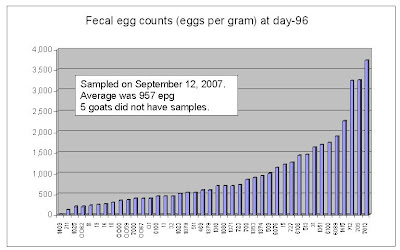On the horizontal (x) axis is the ear tag number of the individual goats. On the vertical (y) axis is the fecal egg count data. If a goat did not have a sample for a particular collection date, it is excluded from the graph (first three graphs).
The final graph shows cumulative fecal egg count totals. All of the goats are included on the x axis, even if they are missing data for one of the collection dates. So if you see missing data, it could be because it had a zero egg count (good!) or it didn't have a sample analysed (no data). Make sure you check the data, before you assume a goat didn't shed any eggs.
If you have difficulty seeing the detail in the graphs, the graphs can be downloaded as full size images in PDF format. Download PDF file.



 When the goats arrived at the test site on June 9, fecal samples were collected from their rectums. These egg counts averaged 634 and ranged from 0 to 5,600 epg. Due to this expected variation and the need to compare fecal data later in the test, all of the goats were dewormed with moxidectin at the start of the test. Moxidectin was used because it is the anthelmintic with the least reported resistance.
When the goats arrived at the test site on June 9, fecal samples were collected from their rectums. These egg counts averaged 634 and ranged from 0 to 5,600 epg. Due to this expected variation and the need to compare fecal data later in the test, all of the goats were dewormed with moxidectin at the start of the test. Moxidectin was used because it is the anthelmintic with the least reported resistance.
As you can see from the graphs, there was considerable variation in fecal data. While averages tended to be "high," only a portion of the goats had high egg counts at each collection date. This supports the idea that only a portion of the herd is responsible for the majority of egg laying and pasture contamination. High average and individual egg counts did not result in clinical parasitism or the need for significant deworming. Excluding the initial deworming, only four goats were dewormed during the test and their needs were marginal (FAMACHA© scores of 3).
High average and individual egg counts did not result in clinical parasitism or the need for significant deworming. Excluding the initial deworming, only four goats were dewormed during the test and their needs were marginal (FAMACHA© scores of 3).
The lack of parasitism is attributed to the drought, as parasites require moisture. The addition of pearl millet to the grazing system may have also contributed, as it is a taller growing forage. Increased grazing heights can reduce parasitism, as most of the infective (L3) worm larvae is found in the first two inches of plant growth. As a warm season grass, the millet also performed better in the drought, providing better nutrition than the dried-up cool season forages.
Despite the lack of clinical parasitism, egg count data is important because a goat that doesn't need dewormed can still be a significant source of pasture contamination, leading to clinical disease in susceptible animals. It is best to select bucks with low egg count data.
Fecal egg counts were determined by Delaware State University using the modified McMaster techique.
Download fecal egg count report.
Download full size images of graphs.











